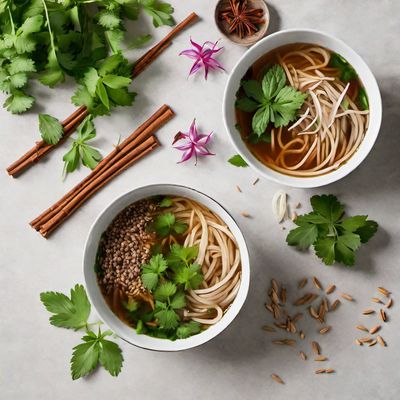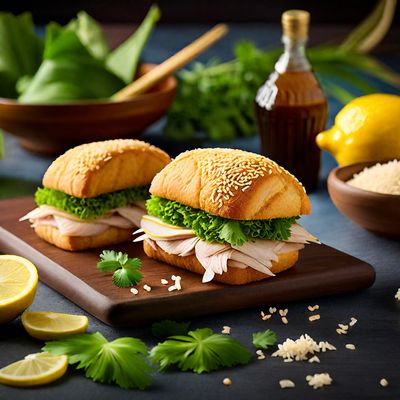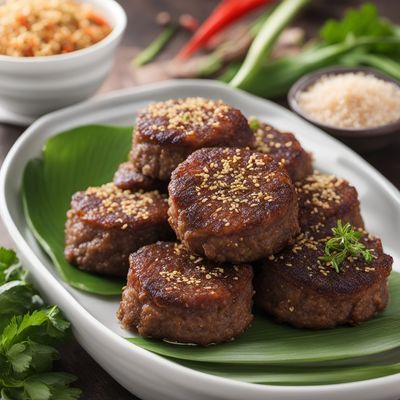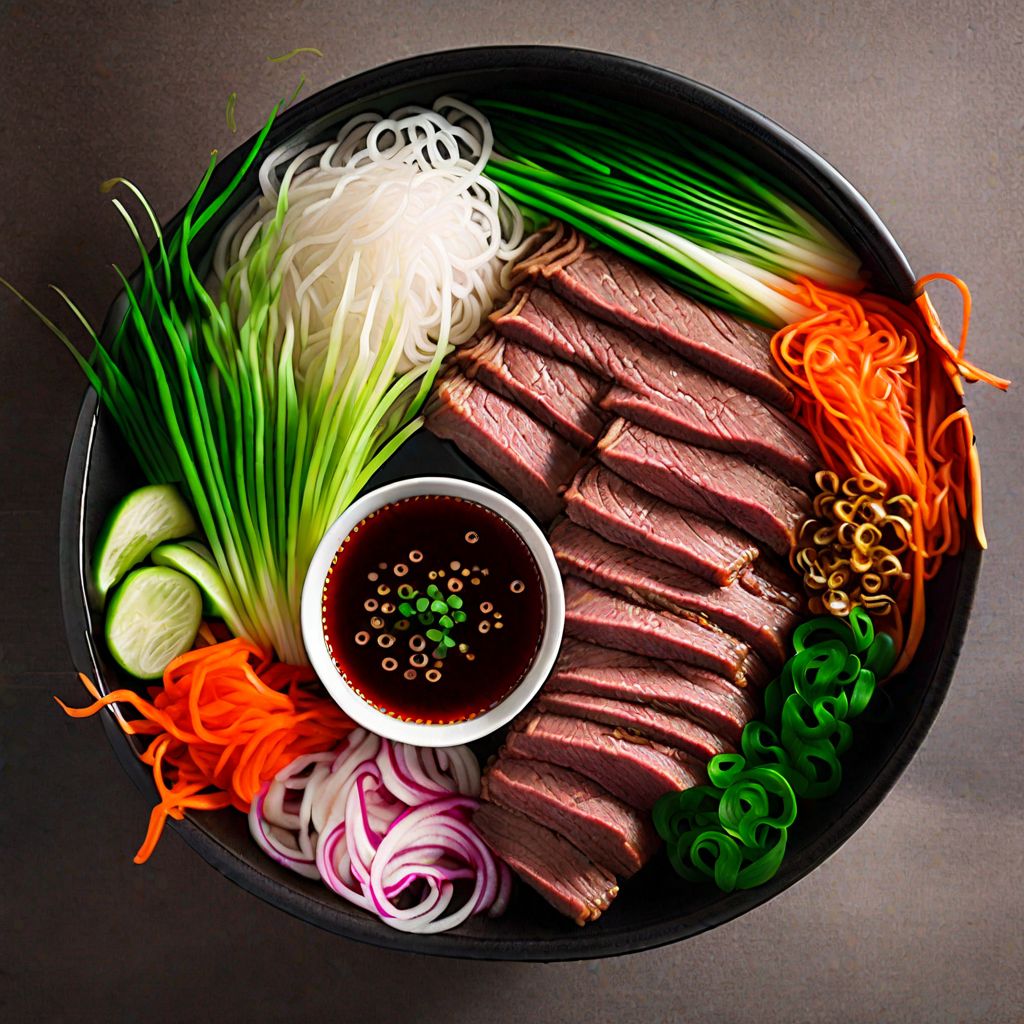
Recipe
Korean-style Beef Pho
K-PHO: A Korean Twist on Vietnamese Classic
4.8 out of 5
In Korean cuisine, bold flavors and hearty ingredients take center stage. This Korean-style Beef Pho combines the comforting elements of traditional Vietnamese Pho with the vibrant and spicy flavors of Korean cuisine. The result is a delicious fusion dish that will satisfy your cravings for both cuisines.
Metadata
Preparation time
20 minutes
Cooking time
30 minutes
Total time
50 minutes
Yields
4 servings
Preparation difficulty
Medium
Suitable for
Gluten-free, Dairy-free, Nut-free, Low-fat, Low-carb
Allergens
Soy (in the soy sauce and gochujang)
Not suitable for
Vegan, Vegetarian, Paleo, Keto, High-protein
Ingredients
While the original Vietnamese Pho typically uses a combination of herbs like Thai basil, cilantro, and bean sprouts, the Korean-style Beef Pho incorporates Korean ingredients such as kimchi and gochujang for a unique twist. The broth is also infused with Korean flavors like garlic, ginger, and soy sauce, giving it a rich and savory taste. We alse have the original recipe for Pho, so you can check it out.
-
1 pound (450g) beef brisket, thinly sliced 1 pound (450g) beef brisket, thinly sliced
-
8 cups (1.9L) beef broth 8 cups (1.9L) beef broth
-
2 tablespoons soy sauce 2 tablespoons soy sauce
-
2 tablespoons gochujang (Korean red pepper paste) 2 tablespoons gochujang (Korean red pepper paste)
-
4 cloves garlic, minced 4 cloves garlic, minced
-
1 tablespoon ginger, grated 1 tablespoon ginger, grated
-
2 tablespoons vegetable oil 2 tablespoons vegetable oil
-
1 onion, thinly sliced 1 onion, thinly sliced
-
4 green onions, chopped 4 green onions, chopped
-
2 cups (470ml) kimchi 2 cups (470ml) kimchi
-
8 ounces (225g) rice noodles 8 ounces (225g) rice noodles
-
Salt and pepper, to taste Salt and pepper, to taste
-
Optional toppings: sliced jalapenos, fresh cilantro, lime wedges Optional toppings: sliced jalapenos, fresh cilantro, lime wedges
Nutrition
- Calories (kcal / KJ): 380 kcal / 1590 KJ
- Fat (total, saturated): 12g, 3g
- Carbohydrates (total, sugars): 40g, 5g
- Protein: 28g
- Fiber: 4g
- Salt: 2.5g
Preparation
-
1.In a large pot, heat the vegetable oil over medium heat. Add the minced garlic and grated ginger, and sauté for 1-2 minutes until fragrant.
-
2.Add the sliced onions and cook until they become translucent.
-
3.Add the beef brisket slices and cook until browned on all sides.
-
4.Pour in the beef broth, soy sauce, and gochujang. Stir well to combine.
-
5.Bring the broth to a boil, then reduce the heat to low and let it simmer for 30 minutes to allow the flavors to meld together.
-
6.While the broth is simmering, cook the rice noodles according to the package instructions. Drain and set aside.
-
7.Once the broth is ready, taste and adjust the seasoning with salt and pepper if needed.
-
8.To serve, divide the cooked rice noodles among bowls. Ladle the hot broth over the noodles, making sure to distribute the beef slices evenly.
-
9.Top each bowl with kimchi, chopped green onions, and any optional toppings you desire.
-
10.Serve the Korean-style Beef Pho hot with a side of sliced jalapenos, fresh cilantro, and lime wedges for squeezing over the soup.
Treat your ingredients with care...
- Beef brisket — For tender beef slices, it's best to thinly slice the brisket against the grain.
- Kimchi — If you prefer a milder flavor, you can rinse the kimchi before adding it to the soup.
Tips & Tricks
- To add an extra kick of heat, sprinkle some Korean chili flakes (gochugaru) on top of the soup.
- If you can't find gochujang, you can substitute it with sriracha or another spicy chili paste.
- Feel free to customize your toppings with additional Korean ingredients like pickled radish or seaweed.
- For a heartier meal, you can add cooked beef or pork bulgogi to the soup.
- Leftover broth can be stored in the refrigerator for up to 3 days and reheated before serving.
Serving advice
Serve the Korean-style Beef Pho piping hot in individual bowls. Garnish with fresh cilantro, sliced jalapenos, and a squeeze of lime juice for added freshness and tanginess.
Presentation advice
To make the dish visually appealing, arrange the beef slices, kimchi, and green onions on top of the noodles before pouring the hot broth over them. This will create a beautiful contrast of colors and textures.
More recipes...
More Vietnamese cuisine dishes » Browse all
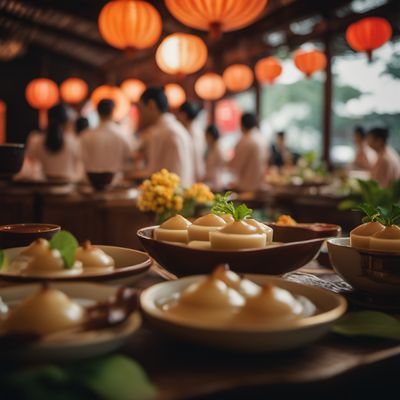
Chè hạt sen
Lotus seed pudding
Chè hạt sen is a Vietnamese dessert made with lotus seeds and coconut milk.

Bánh chuối
Bánh chuối is a traditional Vietnamese dessert made with bananas and sticky rice flour.

Hủ tiếu khô
Dry Hủ Tiếu Noodles
Hủ tiếu khô is a Vietnamese noodle dish that is typically served as a breakfast or lunch dish. The dish is made with thin rice noodles, pork,...
More Korean cuisine dishes » Browse all

Oi sobagi
Cucumber kimchi
Oi sobagi is a traditional Korean side dish made with stuffed cucumbers. It is a refreshing and spicy dish that is often served with rice and...

Yeolmu kimchi
Young Summer Radish Kimchi
Yeolmu kimchi is a traditional Korean dish made with young summer radish greens. It is a refreshing and spicy side dish that is perfect for hot...

Sunga Pork
Sunga Pork is a traditional Filipino dish that is known for its sweet and savory flavor. The dish is made with pork that is marinated in a mixture...

